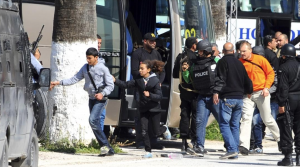On March 19, 2015, two armed men entered a museum in Tunis, the capital of Tunisia, and opened fire, killing 19 people. The assailants specifically targeted a popular tourist destination with the alleged goal of generating maximum impact on behalf of the Islamic State (IS). This example is hardly unique. Between mid-2015 and mid-2016, numerous large-scale attacks against civilians occurred in the capitals of France, Indonesia, Turkey, the UK, and Belgium, to name only a few. Why do insurgents choose to target capital cities? Are these attacks evidence of a global trend? Are there specific circumstances in which attacks on capital cities are more likely?

In a forthcoming paper in the journal Political Geography I provide answers to these questions. Using high-resolution geographic data on insurgent atrocities, this study establishes that the increasing frequency of civilian killings in capitals is part of a specific strategy on the part of the perpetrators. These data also allow me to identify specific symbolic capital city features that explain these patterns.
Firstly, insurgents who commit large-scale violence generally seek to inflict harm on regime functionaries and elites – the people who tend to populate capital cities. Attacking those cities, therefore, makes accomplishing their goal more likely, even compared to other large cities that are not the capital. Moreover, attacks can cause financial harm to these elites, coercing them to negotiate with, or at least recognize, the insurgents.
Secondly, attacking the capital generates strong fears among the civilians by demonstrating that the insurgents can hurt them even if they live at the epicenter of political power, in a city that is itself a symbol of the state’s authority. In doing so, they intimidate the civilians into pressuring the regime to settle with the insurgents. This is true not only for suicide bombings and mass shooting sprees, but also more organized campaigns of violence. For instance, in the few days following their 1999 assault on Freetown in Sierra Leone, Revolutionary United Front (RUF) and military junta troops executed approximately 5,000 civilians blamed for being government “collaborators.” This is arguably unprecedented number of noncombatant casualties for a single campaign in almost eight years of civil war.
Thirdly, insurgents might target the capital to hurt, or at least threaten, the citizens of other countries. Diplomatic envoys, non-government organizations, foreign investors, embassies, and tourists are all highly likely to be present in the capital. By harming foreign citizens, insurgents can generate international impact, which might persuade the governments of their victims to pressure the targeted regime to settle with these groups.
Importantly, these attacks do not happen uniformly. While every insurgent group has some incentives to commit atrocities in the capital, some groups might be more likely to do so.
Groups that fight ethnic wars, for instance, target capitals more frequently, because these cities encapsulate the institutional power of the ruling ethnic group and its control of the security apparatus. Ethnic insurgents also have fewer incentives to use violence selectively against regime supporters, because members of the ruling ethnicity are unlikely to view the insurgents’ cause as just. Therefore, the incentives to both coerce elites and intimidate civilians become even more important in these contexts.
A second type of insurgent group with greater incentive to kill in the capital is secessionists. Secessionist campaigns are frequently the result of true or perceived economic injustice, especially if the region offers valuable natural resources such as oil, or the group represents an ethnic majority. Such groups also frequently have limited military strength, and thus choose to kill civilians in the capital to compensate for their military weakness. By attacking civilians in the capital, secessionist insurgents can “persuade” international investors to withdraw their investment from the regime, and seek alternative routes to obtain any lucrative resources the region might possess.
These findings have policy implications. Most importantly, they strongly suggest that governments, international coalitions, and nongovernmental organizations focus resources on devising new strategies to strengthen security at the gateways to capital cities, particularly in countries and regions where ethic or secessionist insurgents have shown a penchant for mass killing.
Ore Koren is a PhD candidate at the University of Minnesota in Political Science, a pre-doctoral fellow at Dartmouth College, and a former Jennings Randolph Peace Scholar at the United States Institute of Peace, specializing in international relations and methodology. Within international relations, his research has involved innovative approaches to studying the causes of civil conflict and political violence. His methodological interests include limited dependent variable models and applied Bayesian statistics, mixed and combined methods approaches, and event data. His work has appeared or is forthcoming in Journal of Politics, International Studies Quarterly, Political Geography, Journal of Peace Research, Food Security, Conflict Management and Peace Science, and Terrorism & Political Violence, as well as policy outlets such as The Monkey Cage (Washington Post), The United States Institute of Peace Policy Briefs, and Political Violence @ A Glance. He also has a contract with Oxford University Press for a coauthored book about the role of paramilitary groups in post-civil-war situations, and a forthcoming coauthored book at Palgrave Macmillan about the politics of mass killing in authoritarian regimes.

Comments